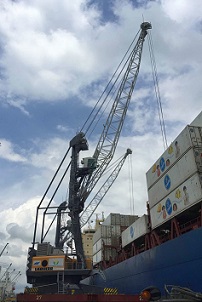Models from across the range have been delivered to various countries. The most sought-after LHM model in Latin America over the past five years, type LHM 600, is still in high demand. In Buenos Aires, Terminal 4 S.A. invested in an LHM 600. This new machine is based on a special design. An elongated tower extension ensures that the position of the tower cabin is higher than 37 metres. Besides better sight into the ship for the crane driver, one striking benefit is a higher fulcrum point which eases the handling of bigger vessels. All advantages come without any influence on safety or operational parameters like lifting capacity and travelling speed. In total, the mighty mobile harbour crane is the seventh LHM for the company and its third LHM 600. Two more units of this
type are going to be delivered to the South American Pacific coast in the upcoming months. Puerto Lirquén is expanding its Liebherr mobile harbour crane fleet with their seventh and eighth unit. Like the new LHM 600 for Argentina, both LHM 600s for the Chilean company are equipped with the elongated tower extension in order to ease the handling of bigger vessels. Thanks to the new machines, the total number of LHM 600s in Latin America rises to 28 units. A new LHM 550 started operation for Termaco in Fortaleza this summer. It is the first Liebherr mobile harbour crane for the Brazilian company. Equipped with a 54 metres boom, the LHM 550 will mainly be used for highly efficient container handling. 2 / 3
Initial orders from Caribbean countries – Haiti, Jamaica and Suriname
A newly built port in the Caribbean is the first Liebherr mobile harbour crane customer in Haiti. In June 2015, Port Lafito received its first mobile harbour cranes. The port opted for two LHM 420s which provide hoisting and lowering speeds of up to 120 metres per minute. Both cranes are equipped with Liebherr’s fleet management system LiDAT. The system allows for crane performance monitoring and key statistics analysis in order to ensure optimum turnover. Additionally, crane drivers benefit from simulation-based training programs which are offered in the Liebherr maritime training centre in Miami, USA. Kingston Wharves Limited opted for their first Liebherr mobile harbour crane which will also be the first of its kind in Jamaica. The new LHM 550 is equipped with a tower elongation and a 54 metres boom. It will mainly be used for container handling. The machine, which is expected to start operation laterthis year in Kingston, will be the biggest and strongest mobile harbour cranein Jamaica.
N.V. VSH Transport is based in Paramaribo, the capital of Suriname. The stevedoring company provides a wide range of services to its customers. In summer 2015, Liebherr delivered its first mobile harbour crane to the Port of Paramaribo which allows for more flexibility in cargo handling. The main task of the LHM 280 is container handling. In 2016, Liebherr is going to deliver the world’s largest mobile
harbour crane to Montecon. The LHM 800 is a future-oriented addition to Montecon’s existing cargo handling fleet. In container handling configuration the eye level is above 40 metres and the fulcrum point is above 36 metres which naturally eases the handling of vessels. Thanks to its mighty outreach of 64metres, the LHM 800 is able to efficiently service container vessels which are as wide as 22 container rows.
Tropical Shipping has provided shipping service to The Bahamas and the Caribbean for more than 50 years. Recently, the American company has invested in their first Liebherr mobile harbour crane, type LHM 420. In summer 2015, the new crane started operation in West Palm Beach, Florida. Big crane models still dominate the mobile harbour crane orders from Latin America. In 2015, the LHM 600 is again the favourite choice, as it was in 2013 and 2014. Next year’s delivery of the giant mobile harbour crane LHM 800 to Uruguay will mark a new highlight in this regard.
Caption
Three LHM 420s have been handling containers in Guatemala since 2014.



